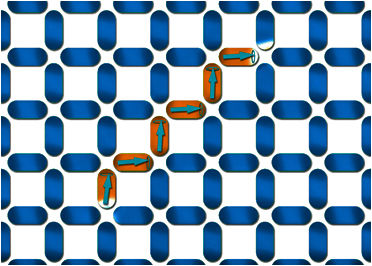Looking for clues in spin ice: Spectral fingerprint of magnetic monopoles discovered
An international team of researchers including scientists from Jülich have proposed a new method to identify and analyse exotic material properties in certain nanostructured magnets using experiments. The researchers hope that this will allow such properties in artificial spin-ice materials to be detected more easily, which could be used one day to develop novel logic elements for data processing.

Monopole-antimonopole structure (orange) in an artificial spin-ice lattice composed of magnetic elements (blue).
S. Gliga / Argonne National Laboratory
Spin-ice materials possess unusual properties. For example, magnetic monopoles and antimonopoles can form within them in pairs connected via strings of magnetic elements. The physicists used computer simulations to show that such magnetic structures in artificial spin ice can be identified by characteristic oscillations in the microwave range. Like a fingerprint, the oscillations tell us about the occurrence of monopoles and their frequency in the sample being investigated. The oscillations can be initiated by exciting the samples using magnetic field pulses, for example, or laser pulses.
As the monopole structures can be selectively positioned and moved in the artificial spin ice, the researchers propose using them to design novel logic elements in which magnetic waves will flow instead of electric charges. The monopole structures in these logic elements would have a function similar to a breakwater, which controls the propagation of waves. Using techniques such as lithography, artificial spin-ice materials can be made up of engineered nanoscale areas that are small enough to function as single magnetic elements.
Original publication
Other news from the department science

Get the chemical industry in your inbox
From now on, don't miss a thing: Our newsletter for the chemical industry, analytics, lab technology and process engineering brings you up to date every Tuesday and Thursday. The latest industry news, product highlights and innovations - compact and easy to understand in your inbox. Researched by us so you don't have to.





























































